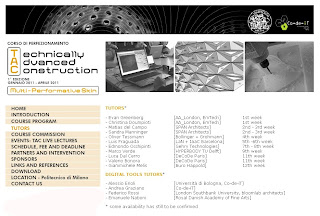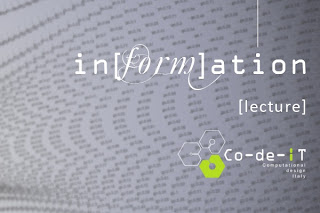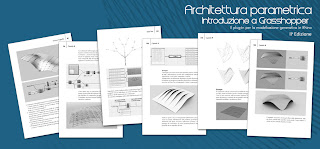TAC shifts forward!
Since we did not reach the minimum number of participants,
TAC calendar shifts from January to April 2011. New applications will start in January 2011.
Stay tuned for upcoming news!
------------------------------------------------------------------------------------------------
ITAFinalmente dopo mesi spesi nella preparazione ed organizzazione posso condividere la notizia dell'attivazione del Corso di perfezionamento "T.A.C. - Technically Advanced Construction" che con Alessio Erioli e il dipartimento BEST del Politecnico di Milano nella persona della Prof.sa Ingrid Paoletti abbiamo organizzato per l'inizio del 2011.
T.A.C. credo sia un corso innovativo (in Italia) sotto molti aspetti. Innovativo per gli argomenti affrontati. Innovativo per le persone chiamate a trasmettere conoscenza e a seguire costantemente i partecipanti. Innovativo probabilmente anche per le modalità con cui è organizzato.
Ovviamente vi chiedo di diffondere tramite i vostri canali, ufficiali e non, la notizia del corso e se siete a conoscenza di eventuali persone, enti o realtà che potrebbero sponsorizzare l'evento ... non fatevi problemi a comunicarcelo! TAC Technically Advanced Construction
TAC Technically Advanced Construction è un corso di perfezionamento per laureati e professionisti promosso dal Dipartimento di Scienza e Tecnologie dell'Ambiente Costruito (BEST) del Politecnico di Milano. Avrà una durata di tre mesi e permetterà ai partecipanti di raggiungere livelli specifici di conoscenza nel processo di "design-to-production" tramite l'uso di strumenti digitali avanzati per la progettazione e macchinari per la creazione e lo sviluppo di modelli fisici.
L'intero corso, con sede al Politecnico di Milano, si svolgerà attraverso studi, workshop, e periodi di lavoro costantemente assistiti (durante lo sviluppo, la fabbricazione e i test di prova) da uno staff di professionisti e
insegnanti altamente specializzati (provenienti da studi e scuole internazionali come AA London, ARUP, Buro Happold, Zaha Hadid, Gehry Technologies, SPAN Architects...).
L'obiettivo è la progettazione, la prototipazione, e infine il collaudo di "multi-performative skins" tramite software per il design computazionale. Le verifiche in itinere delle performance della "skin" costituiranno il feedback principale per ottimizzare il design finale.
Il corso TAC sarà affiancato e completato da una serie di lectures "live" aperte a tutti e gratuite, tenute dagli stessi tutors del corso e da professionisti e insegnanti di fama internazionale.
Il corso inizierà il 17 gennaio 2011 e terminerà il 15 aprile 2011 (frequenza giornaliera).
Le registrazioni sono aperte fino al 13 dicembre 2010.
[Voglio anche ringraziare in questo post Matteo Lo Prete per il suo apporto fondamentale alla creazione del corso e Elena Scripelliti per il prezioso contributo nella stesura del materiale e dei contenuti oltrechè nella gestione del tutto. Un grazie doveroso anche all'Arch. Francesco Vaj per l'aiuto alla realizzazione del sito.]---------------------------------------------------------
ENGFinally, after months spent in the design, preparation and organization together with Alessio Erioli and BEST department of Politecnico di Milano in the person of Professor Ingrid Paoletti, we can share the news of the activation of a Postgraduate course "TAC - Technically Advanced Construction";course will start at the beginning of 2011.I think T.A.C. is an innovative course in Italy under many aspects. Innovative topics covered. Innovative for the people involveded to transmit knowledge and to keep track of participants. Probably also for the innovative way it is organized.Of course, I ask you to spread through your channels, official and unofficial, the news of the course and if you know of any persons, companies or realities that could sponsor the event ... feel free to communicate us! TAC Technically Advanced Construction
TAC Technically Advanced Construction is a new postgraduate course for graduates and professionals established by the Department of Building Environment Science and Technology (BEST), Politecnico di Milano. It will run for three months and will allow participants to achieve high levels of knowledge in the design-to-production process through the use of advanced digital tools for design and machines for t...he creation of physical models.
The entire course, based at the Polytechnic of Milan, will take place through studies, workshops and working periods assisted (during the development, manufacture and test trial) by a team of highly skilled professionals and
teachers (from studies and international schools like AA London, ARUP, Buro Happold, Zaha Hadid, Gehry Technologies, SPAN Architects ...).
The objective is to design, prototype, and finally test "multi-performative skins" through computational design software. Audits in progress performance of the "skin" will be the main feedback to optimize the final design.
The course will be completed by a series of public lectures held by the same course tutors and other professionals and teachers of international renown.
The course will start on January 17, 2011 and will end on April 15, 2011 (daily attendance).
Registration are open until December 13, 2010.
----------------------------------------------------------
Link
http://www.tac.polimi.it/index.html


















